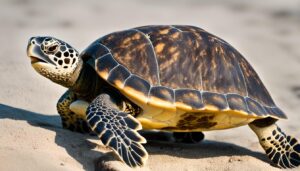Hawksbill Turtle A Jewel of the Ocean
The hawksbill turtle (Eretmochelys imbricata) is one of the most captivating creatures of the sea, known for its striking appearance and crucial role in maintaining the health of coral reefs. Despite its beauty, this species is critically endangered, making efforts to protect it more important than ever.

What Makes the Hawksbill Turtle Unique?
The hawksbill turtle is easily recognizable by its narrow, pointed beak, resembling that of a bird of prey—hence the name “hawksbill.” Its shell, often referred to as “tortoiseshell,” is a mosaic of amber, brown, and gold, which has unfortunately made it a target for illegal poaching. This unique shell is not just beautiful; it also plays a vital role in the turtle’s ability to camouflage among the coral reefs it calls home.
The Role of Hawksbill Turtles in the Ecosystem
Hawksbill turtles are essential to the health of coral reefs. They feed primarily on sponges, which can overgrow and smother the coral if left unchecked. By keeping sponge populations in balance, hawksbills help maintain the biodiversity of the reef, supporting countless marine species.
Where Can You Find Hawksbill Turtles?
These turtles are typically found in tropical waters, particularly around coral reefs in the Atlantic, Pacific, and Indian Oceans. Some of the most notable locations where hawksbill turtles are observed include the Caribbean, the Seychelles, and the Great Barrier Reef.
The Challenges They Face
Despite their important ecological role, hawksbill turtles are critically endangered. The primary threats they face include:
- Illegal Trade: Their beautiful shells have been highly prized for centuries, leading to extensive poaching.
- Habitat Loss: Coastal development and climate change have reduced their nesting and feeding habitats.
- Bycatch: Many hawksbills are accidentally caught in fishing nets, leading to injury or death.
- Pollution: Plastic waste and other pollutants pose significant risks to their health.
Conservation Efforts
Conservationists worldwide are working tirelessly to protect hawksbill turtles. Efforts include protecting nesting sites, enforcing laws against illegal trade, and raising awareness about the dangers of pollution. Organizations like the World Wildlife Fund (WWF) and the Sea Turtle Conservancy are at the forefront of these initiatives, often involving local communities in conservation work. animal
How You Can Help
You can contribute to the protection of hawksbill turtles by supporting conservation organizations, reducing your plastic use, and spreading awareness about the importance of these turtles to our oceans. When traveling to coastal areas, choose eco-friendly tours that support local conservation efforts and respect wildlife.